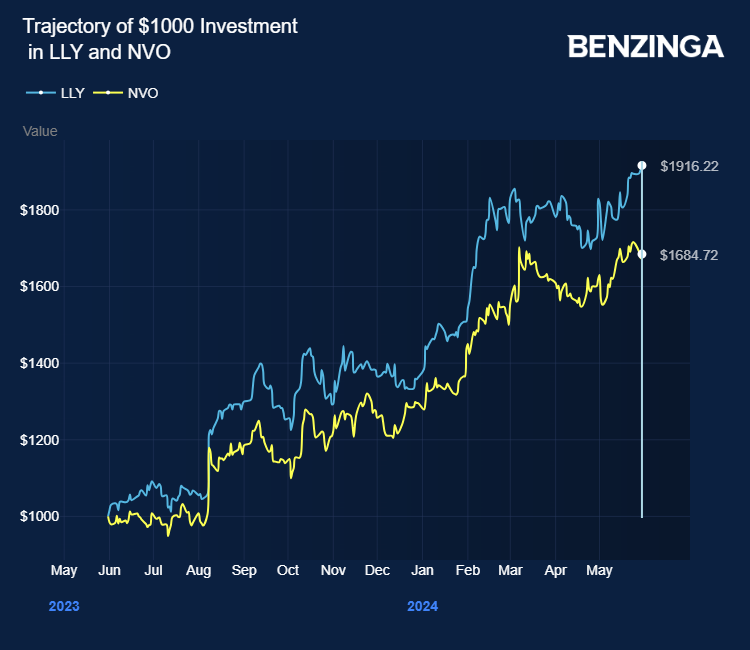Zinger Key Points
- Goldman Sachs re-rated Eli Lilly and Novo Nordisk, expecting global weight-loss drug sales to reach $130 billion by 2030.
- Analyst Chris Shibutani raised Eli Lilly's price target to $785, forecasting significant revenue growth for their AOM portfolio.
- Analyst James Quigley maintained a Buy rating on Novo Nordisk, citing their strong position in obesity treatment.
- China’s new tariffs just reignited the same market patterns that led to triple- and quadruple-digit wins for Matt Maley. Get the next trade alert free.
Goldman Sachs analysts re-rated Eli Lilly And Co LLY and Novo Nordisk A/S NVO, citing the potential for their weight-loss drugs.
The firm expects the global sales of weight-loss drugs to reach $130 billion by 2030, an increase from their prior $100 billion forecast.
Analyst Chris Shibutani maintained a Neutral rating on Eli Lilly with a price target of $785, up from $740.
Shibutani forecasts revenues for the company’s AOM portfolio (including the currently commercialized tirzepatide products Monjouro and Zepbound) in 2024 to $5.3 billion (up from the prior $4.7 billion), 2027 to $27.6 billion (versus the previous $28.2 billion), and 2030 to $56.6 billion (versus the earlier $49.7 billion).
Based on BMI criteria, the analyst continues to see the potential for approximately 110 million people in the U.S. to be eligible for AOM.
According to Shibutani, the combined leading commercial players, Eli Lilly and Novo Nordisk, will likely sustain their dominant share and market leadership.
The analyst expects the players to retain ~ 80% share of the global market through 2030, building on their vast scientific understanding, their ability to continue capitalizing on their first-to-market timing advantages, and their competitive moats.
Analyst James Quigley reiterated a Buy rating on Novo Nordisk with a price target of $156.
Quigley noted Novo’s on-market assets and pipeline put the company in a position to maintain its leadership in obesity.

In particular, significant investments in manufacturing capacity and clinical trial data (SELECT) that suggest that losing weight with Wegovy can reduce the risk of cardiovascular (CV) events, which remain the number 1 cause of death globally, give Novo a critical competitive edge.
Beyond obesity, Novo continues to innovate in its core areas (diabetes and rare diseases) while branching out into adjacent areas, diversifying the platform, and increasing the opportunities for long-term growth, the analyst added.
For Novo Nordisk, over the next 12 months, Quigley noted several vital catalysts that could drive upside, with CagriSema as the pivotal pipeline readout with scope to unlock the next significant anti-obesity asset for Novo Nordisk.
Other catalysts included the recent phase 3 readout for Mim8, providing a meaningful non-obesity asset.
In the long term, the analyst noted that the Phase 2 data for subQ amycretin in 2025 is essential to showcase Novo Nordisk’s pipeline beyond semaglutide and its potential in the rich obesity/diabetes-related pipeline.
Quigley’s forecasts are, on average, 10%, 11%, and 3% above Visible Alpha Consensus Data on net sales, EBIT, and EPS in 2028, driven by higher Ozempic and Wegovy net sales.
Price Actions: At the last check on Thursday, LLY shares traded higher by 0.71% at $817.10. NVO is up 0.74% at $133.60.
Image Via Shutterstock
Edge Rankings
Price Trend
© 2025 Benzinga.com. Benzinga does not provide investment advice. All rights reserved.
date | ticker | name | Price Target | Upside/Downside | Recommendation | Firm |
|---|
Trade confidently with insights and alerts from analyst ratings, free reports and breaking news that affects the stocks you care about.